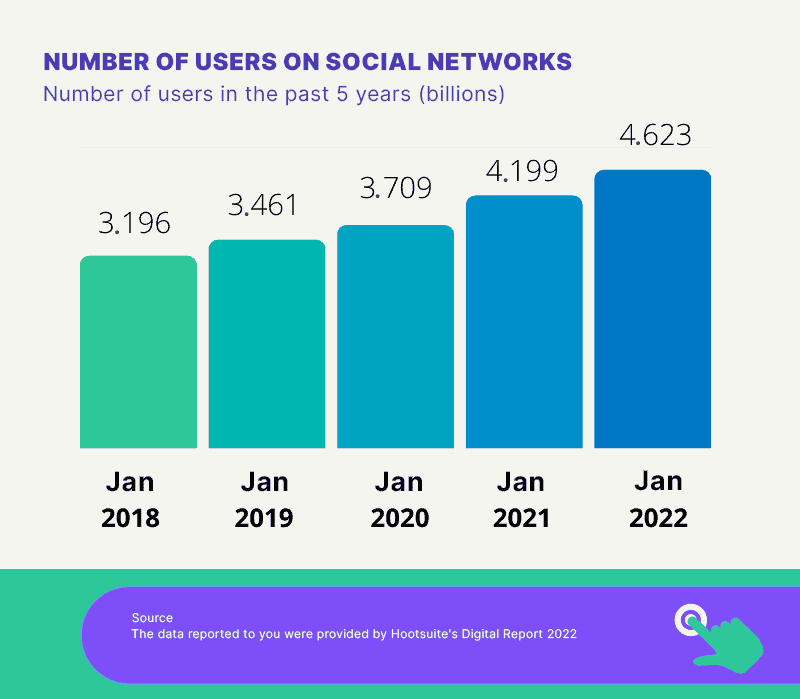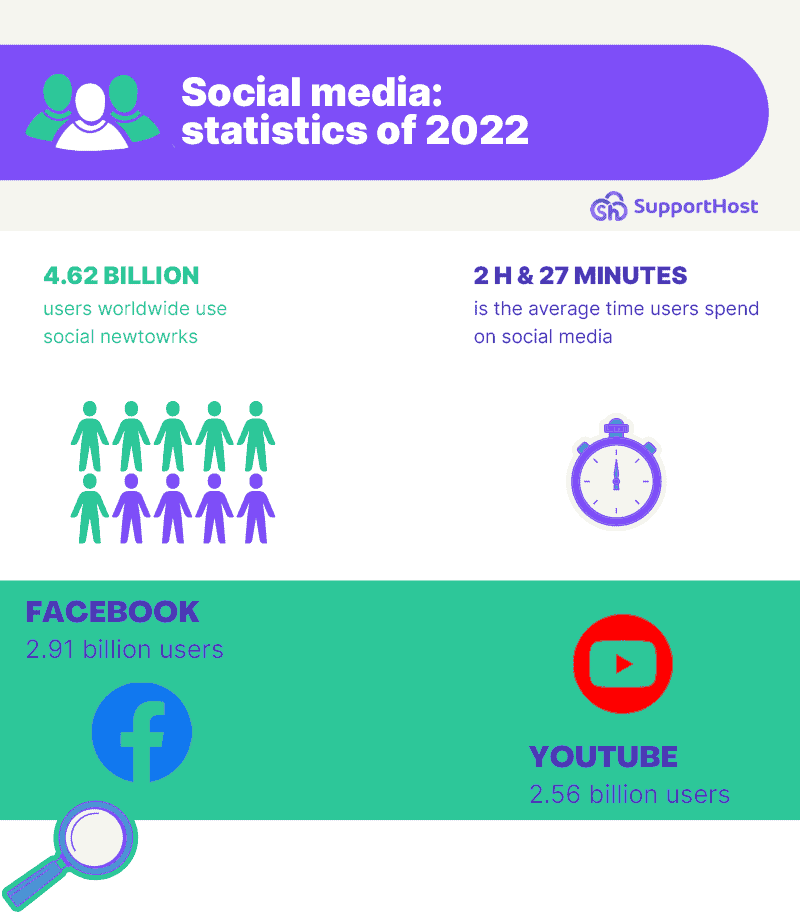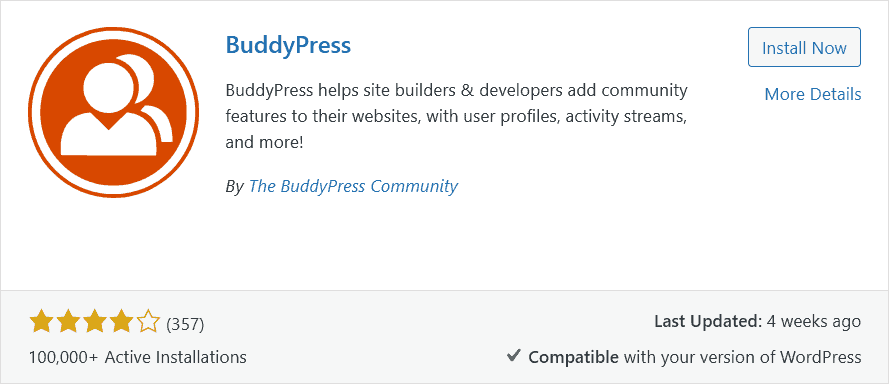Are you wondering how to create a social network?
How do you come up with ideas for a new social network?
In this article we see how to take the first steps, identify the sources of income for the project, define a budget and much more.
Let’s start immediately from the state of the art with updated statistics on the use of social networks.
Table of Contents

How many people use social media?
Before seeing how to create a social network from scratch, let’s take a step back.
Why should you create one?
Some numbers on social media usage will help you get an idea of its potential.
In 2022, there are 4.62 billion users using social media, a number that is growing year after year as you can see from these statistics from 2018 to 2022.

In a nutshell:
- compared to 2021 there was a 10.1% increase in the number of users on social media;
- the most used social network is Facebook with 2.91 billion users (October 2021);
- in second place for number of users we find YouTube with 2.56 billion;
- on average, 2 hours and 27 minutes are spent on social media a day (data from the third quarter of 2021).

How to create a social network: where to start
To create a social network we must outline the fundamental points to follow:
- choose the type of social media based on the audience we want to reach;
- think of a system to earn through the platform;
- take care of the actual development: from the functions, to the testing and launch phases.
Let’s see these steps one by one.
Choose the type of social network you want to create
Knowing the different types of social networks allows us to understand which one to orient towards.
You have to start from the audience you want to address to understand what kind of social network to create.
Let’s see what kind of considerations we have to make.
What are the types of social networks?
The platforms can be divided in many ways, for the target audience and the purpose of use we have:
- social networks for sharing (e.g. Facebook and Twitter);
- social media with a focus on multimedia content (e.g. Instagram, YouTube, Flickr and TikTok);
- professional social networks or for companies (e.g. LinkedIn);
- social networks for relationships and meetings (e.g. Tinder);
- social with discussions and forums (e.g. Reddit and Quora).
Each of these social networks is designed to respond to a user need.

Social networks like Facebook have more objectives, they allow people with similar interests to communicate and to maintain contact with friends and acquaintances.
Social networks like LinkedIn are designed to build a professional level network, while Reddit and other similar platforms help exchange advice based on a question and answer system.

Furthermore, each platform has precise rules regarding content. It is no coincidence that there are social networks that focus on a single type of content, such as YouTube which focuses only on the video format and live broadcasts.
For a more detailed overview of the top socials, check out our post on social media marketing.
How to choose the target audience?
Why do you want to create a social network? Who will it be for?
You can start from a list of ideas, here are some examples:
- a discussion platform for exchanging buying advice;
- a social network to keep in touch with classmates;
- a social network focused on multimedia content and with a focus on travel.
Try to make a list with a lot of information, in order to define a precise niche.

Having a list to start with is not enough.
At this point you have to do a market analysis to understand if your idea can be put into practice. This means that you will need to consider:
- if there are other similar platforms and if they are successful;
- what you can offer that these platforms don’t have.
This analysis will help you narrow down the list of ideas by excluding those that have no market and ideas that are not feasible.
How to make the social network monetizable?
If you want to create a social network and make money, you need to define a monetization strategy.
Let’s see some of the systems that can be used.
Make money with social media advertising
One of the most used systems is to use advertisements to make profits from sites and blogs.

The same system can also be applied to social networks with the use of banners or sponsored posts such as those you can see on Facebook and Instagram.
For insights into the different types of income from advertising, you can check out our guide on how to make money blogging.
Earning with Affiliates
In addition to being able to use banners and earn from advertising, you can also go the route of affiliate marketing.

You can join an affiliate program and insert banners on your social network. This way you can earn commissions when a user makes a purchase using your link.
Offer paid features and content
Another way to make money with your social network is to include paid features. For example, tools to customize your profile or other functions that you will only make available for a fee.
Create a social network with a subscription
You can also allow users who join your social network to have two forms of registration: free or paid.
In this case you will have to guarantee additional functions to the members who subscribe to the paid membership. An example of this system is the one used by LinkedIn with premium accounts.
Creating a social network: what to know about development
In the previous sections we have seen that everything starts from defining ideas for a new social network.
After creating your list, you will have to narrow it down by eliminating those proposals that have no market or are not feasible.

At this point you have to define all the details of the project. We’ll start by establishing what functions and what appearance the social network will have and then move on to practice, that is to say the creation of the social network.
A test phase will follow and, finally, the launch of the new project.
Define functions and structure of the social network
To determine which features you will need to make available, you need to consider the type of social network you want to create.
Let’s look at some examples of basic functions that you might want to use with your new social network.
Profile management
A social network cannot lack tools that allow users to customize their profile.

Each social network has its own characteristics, for example on Facebook users have a bulletin board where content is shown starting from the most recent ones.
Some platforms allow you to customize the look of your profile. For example, you can choose what to show to other users, highlight content and, very importantly, manage privacy.
Creating a news feed
Most social networks have a news feed for users to engage with posts and content and share their own.
In some cases, there are also suggestions sections that show popular or similar content to the one we interacted with. For example, the Explore sections of YouTube and Instagram.
Content management
You need to determine what content will be allowed to be published on your platform. This means that you will have to choose the accepted formats and the way they will be displayed.
Let’s see some practical examples by examining the most popular social networks and how the contents are structured.

On Facebook, multimedia content is highlighted, for example the photo or video of the post, when present. At the same time, however, the description and therefore the text is also highlighted, which is in fact shown in the foreground.
A different situation occurs on social networks such as YouTube and Instagram where the multimedia content is the key element, and the descriptions are shown in the background.
You will also need to establish the accepted multimedia formats, as you know, in fact, each social network has its own guidelines for multimedia content, and these evolve over time. For example, the dimensions of photos on Instagram have changed since they moved exclusively from the square format to accepting other portrait and landscape formats as well.
User interaction management
What kind of communication do you want to have between users of your social network?
You can choose whether to integrate an instant messaging system and use contact list systems as in most social networks.

You will also be able to define user search systems to allow them to establish new connections and create their own network of contacts.
Do you want users of your social network to be able to exchange files? Consider putting a feature in messaging to support attachments like photos, videos or documents as well.
Another essential feature is the integration of notifications to alert users when there is an interaction with a post, link request, and so on.
If your company uses many communication channels, you can integrate a UCaaS platform. This way, you’ll combine your social media messages with all your other channels into one interface, preventing miscommunications that negatively impact customer experience.
Options for sharing and interacting with content
The possibility of interacting with others is the basis of the creation of a social network that is popular with users.
Can the contents published on your social platform be shared? What kind of interaction do you want to allow?
Think of the social networks we already know, like Facebook with reactions, or YouTube with “likes” and “dislikes” and start from there.
Integration with other social networks
It may be useful to insert an integration system with other social networks to share content on multiple platforms. Think, for example, of Facebook and Instagram which allow you to post the same content on the two social networks.
Tools for content creators: statistics and advanced editors
If you want to create a social network designed for content creators, you will also need to introduce a statistics system and an advanced editor for content creation.

An example of statistics is given by Facebook Insights which allow users who manage the pages to check the progress of the contents and the level of public involvement.
As far as editors are concerned, you can think of YouTube studio, the section of the social network from which you can customize the channel, manage and edit the contents before publishing.
How to make a social network: design and development
After defining what the functions of your social network will be, you will have to move on to the actual implementation.
In this phase you will need the support of designers and developers who will create a prototype of the social network you want to create. From this first draft you can then move on to the actual development which includes two elements: front-end and back-end.

The back-end is everything behind the platform that is not shown to the end user who will use the social network and who will only have access to the font-end. Back-end development can involve several elements.
You may need an administration panel that allows you to manage the platform. You will also need a database in which the data will be stored. In some cases you may also need to implement a payment system.
The development of the front-end, on the other hand, concerns everything that will be seen by the users of the social network and therefore includes the functions and the aspect that the platform will have to have.
Is your social network ready? It’s testing time
When development is complete, you cannot directly launch the platform. It’s important to make sure everything is working properly, and testing is needed to do that.
These tests are used to make sure that all functions and the interface of the social network are actually operational.

In addition, safety tests are needed. In fact, don’t forget that social networks often deal with a multitude of sensitive data and it is your duty to make sure that this data does not fall into the wrong hands.
Last but not least, we must also consider the performance and usability of the platform.
How to create a social: the moment of launch
After the social has been tested, usually in a staging i.e., a development environment, it comes time to take the site into production.
The launch of a social network must be accompanied by a promotion, which can usually even precede the actual launch by a short period.

Marketing campaigns to announce the arrival of a new social network can include various communication channels. For example, you could launch email campaigns and involve influencers and prominent personalities.
How much does it cost to create a social network?
After having seen where to start to create a new social network, let’s move on to another key element: the budget available. How much money is needed to make it?
To understand what the cost is to create a social network, you need to make some assumptions about the creation of the site.
There are several alternatives to create a social network, but we can divide them into two main options:
- entrust the development to a team of professionals;
- create it from scratch in a do-it-yourself way.
Let’s see what are the advantages and disadvantages of these two alternatives and let’s make some considerations on the costs.
DIY or professional solutions: costs, pros and cons
In the case of DIY, the simplest system is to use a CMS and extensions already designed for this purpose. Or a platform already set up to create a social network.
Surely the do-it-yourself method allows you to start creating a social platform even with reduced technical knowledge and a lower budget.
By choosing this path, you can use a CMS such as WordPress and use a plugin such as Buddypress which allows you to transform the site into a social network.

Also, for Joomla there are addons like JomSocial created for this purpose.
In these cases, the necessary budget is not high. As for the infrastructure, if you don’t expect high user traffic, you could start with shared hosting for €34 a year with the CMS already pre-installed.
If, on the other hand, you need assistance to configure and start the social network, you will also have to consider additional costs.
This regards the creation of a social network with WordPress or other open-source CMS in a completely (or almost) do-it-yourself way.
The issue, however, becomes more complex when you have to develop a real platform with specific functions to have maximum control and customization.
In this case the necessary budget is higher because the development involves more than one professional. You will need an entire team to take care of: design, development (front-end and back-end), testing phases and in some cases even marketing campaigns to launch the platform.

The cost of a social network cannot be defined in advance because it depends on various factors: the type of functions required, the requirements of the platform that will be used and so on.
To give a rough indication, the price can be around 20-50 thousand euros for development. Then there are also the costs of maintaining the platform and advertising campaigns to consider.
To get a more precise idea, if you have already outlined the characteristics and functions of the social network you want to create, the best solution is to request a development estimate.
You’ll also need to make different considerations when it comes to infrastructure. A high traffic site will need a high performance and scalable hosting solution such as a dedicated server or a VPS cloud hosting plan.
Conclusion
We have seen how to take the first steps to understand how to create a social network. As with all projects, you have to start from an idea and carry out analyzes to understand if the idea is feasible.
The preliminary phase is followed by another equally crucial one: that of development. In this phase, the budget available plays a fundamental role. What social network do you want to create? And how much money do you have to do it?
From here you can start laying the foundations for your project and get closer to your goal. Do you have any questions or considerations to make? Let us know with a comment.



Leave a Reply